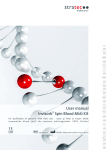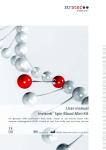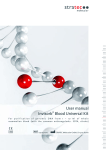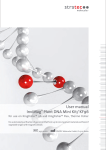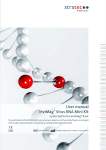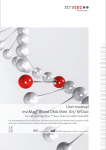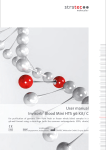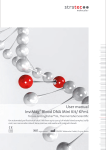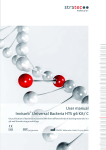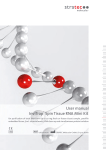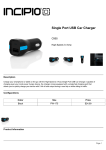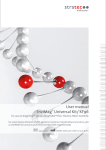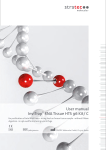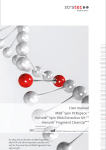Download Invisorb DNA Plant HTS 96 Kit/ C User manual
Transcript
User manual Invisorb® DNA Plant HTS 96 Kit/ C for purification of genomic DNA up to 50 mg of a wide variety of plant species in a 96-well format using a centrifuge REF 7037300x00 STRATEC Molecular GmbH, D-13125 Berlin Instruction for Invisorb® DNA Plant HTS 96 Kit for 96 DNA extractions from up to 50 mg of plant material for use on a centrifuge The Invisorb® DNA Plant HTS 96 Kit has been designed to purify extremly fast genomic DNA from up to 50 mg plant material using a centrifuge. The newly patented technology for isolation of genomic DNA by binding onto the filter surface does not need any hazardous chaotropic buffer components. The isolation protocol as well as all buffers is optimized to provide high yield and purity of the extracted genomic DNA. The “hands-on time“ necessary for the whole procedure is reduced to a minimum. Trademarks: Invisorb®, Registered marks, trademarks, etc. used in this document, even when not specifically marked as such, are not to be considered unprotected by law. The Invisorb® technology is covered by patents and patent applications: US 6,110363, US 6,043,354, US 6,037,465, EP 0880535, WO 9728171, WO 9534569, EP 0765335, DE 19506887, DE 10041825.2, WO 0034463. Invisorb® is a registered trademark of STRATEC Biomedical AG. The PCR process is covered by US Patents 4,683,195, and 4,683,202 and foreign equivalents owned by Hoffmann-La Roche AG. © 2013 STRATEC Molecular, all rights reserved. 1 ® Invisorb Plant DNA HTS 96 Kit/ C 0213 Contents Kit content of Invisorb® DNA Plant HTS 96 Kit/ C 3 Symbols 4 Storage 4 Quality control and product warranty 4 Intended use 5 Product use limitation 5 Safety information 6 Product characteristic of the Invisorb® DNA Plant HTS 96 Kit/ C 7 Yield and quality of genomic DNA 7 Sampling and storage of starting material 7 Important points before starting a protocol 7 Preparing reagents and buffers 8 Reagents and equipment to be supplied by user 8 ® Scheme of Invisorb DNA Plant HTS 96 Kit/ C 9 Principle and procedure 10 Protocol: DNA extraction from plant material for use on a centrifuge 10 Troubleshooting 13 Appendix 14 Ordering information 15 2 ® Invisorb Plant DNA HTS 96 Kit/ C 0213 Kit contents of Invisorb® DNA Plant HTS 96 Kit/ C Store diluted Proteinase K at - 20°C, but repeated freezing and thawing will reduce the activity dramatically. Dividing the Proteinase K into aliquots and storage at - 20°C is recommended. Store all other kit components at room temperature (RT)! 2 x 96 DNA extractions 4 x 96 DNA extractions 24 x 96 DNA extractions Catalogue No. 7037300200 7037300300 7037300400 Lysis Buffer P 2 x 40 ml 4 x 40 ml 24 x 40 ml 24 ml (final volume 80 ml) 2 x 24 ml (final volume 2 x 80 ml) 270 ml (final volume 900 ml) Elution Buffer 30 ml 60 ml 350 ml Proteinase K 2 x 2 ml 4 x 2 ml 24 x 2 ml RNase A 2 x 4 ml 4 x 4 ml 24 x 4 ml Wash Buffer I 80 ml (final volume 160 ml) 2 x 80 ml (final volume 2 x 160 ml) 2 x 350 ml (final volume 700 ml) Wash Buffer II 2 x 45 ml (final volume 2 x 150 ml) 4 x 45 ml (final volume 4 x 150 ml) 4 x 270 ml (final volume 900 ml) 2.0 ml Collection Plate 4 2x4 12 x 4 Elution Plate L 2 4 24 Prefilter Plate 2 4 6x4 DNA Binding Plate D 2 4 6x4 Plate Lid 4 8 48 Sealing Foils 2 4 24 Manual 1 1 1 Add 56 ml 99.7% Isopropanol to the Binding Buffer A. Mix by intensive shaking by inverting for 1 min. Shortly before use mix by inverting several times. Add 56 ml 99.7% Isopropanol to each Binding Buffer A. Mix by intensive shaking by inverting for 1 min. Shortly before use mix by inverting several times. Add 630 ml 99.7% Isopropanol to the Binding Buffer A. Mix by intensive shaking by inverting for 1 min. Shortly before use mix by inverting several times. Binding Buffer A Initial steps Add 75 ml 96-100% ethanol to Add 75 ml 96-100% ethanol to Add 350 ml 96-100% ethanol each bottle Wash Buffer I to each bottle Wash Buffer I the bottle Wash Buffer I Add 105 ml of 96-100% ethanol to each bottle Wash Buffer II, mix shortly and keep the bottle always firmly closed! Add 105 ml of 96-100% ethanol to each bottle Wash Buffer II, mix shortly and keep the bottle always firmly closed! Add 2 ml ddH2O to each tube Proteinase K, mix thoroughly and store at -20°C ! Add 2 ml ddH2O to each tube Add 2 ml ddH2O to each tube Proteinase K, mix thoroughly Proteinase K, mix thoroughly and store at -20°C ! and store at -20°C ! 3 ® Add 630 ml of 96-100% ethanol to each bottle Wash Buffer II, mix shortly and keep the bottle always firmly closed! Invisorb Plant DNA HTS 96 Kit/ C 0213 Symbols Manufacturer Lot number Catalogue number Date of manufacture Expiry date Consult operating instructions Temperature limitation Do not reuse Storage All buffers and kit components of the Invisorb® DNA Plant HTS 96 Kit/ C should be stored at room temperature (RT) and are stable for 12 months under these conditions. Room temperature (RT) is defined as range from 15 - 30°C. Dissolved Proteinase K stored at – 20°C is stable for 12 months, but repeated freezing and thawing should be avoided. Aliquotation and storage at – 20°C is recommended. Wash Buffer charged with ethanol should be appropriately sealed and stored at room temperature. If there are any precipitates within the provided solutions dissolve these precipitates by carefully warming up to room temperature (up to 30°C). Quality control and product warranty STRATEC Molecular warrants the correct function of the Invisorb® DNA Plant HTS 96 Kit/ C for applications as described in this manual. Purchaser must determine the suitability of the Product for its particular use. Should any Product fail to perform the applications as described in the manual, STRATEC Molecular will check the lot and if STRATEC Molecular investigates a problem in the lot, STRATEC Molecular will replace the Product free of charge. STRATEC Molecular reserves the right to change, alter, or modify any Product to enhance its performance and design at any time. In accordance with STRATEC Molecular’s ISO 9001-2000 and ISO EN 13485 certified Quality Management System the performance of all components of the Invisorb® DNA Plant HTS 96 Kit/ C have been tested separately against predetermined specifications routinely on lot-to-lot to ensure consistent product quality. If you have any questions or problems regarding any aspects of Invisorb® DNA Plant HTS 96 Kit/ C or other STRATEC Molecular products, please do not hesitate to contact us. A copy of STRATEC Molecular’s terms and conditions can be obtained upon request or are presented at the STRATEC Molecular webpage. For technical support or further information please contact: from Germany +49-(0)30-9489-2901/ 2910 from abroad +49-(0)30-9489-2907 or contact your local distributor. 4 ® Invisorb Plant DNA HTS 96 Kit/ C 0213 Intended use The Invisorb® DNA Plant HTS 96 Kit/ C is the ideal tools for a rapid and efficient isolation of high quality genomic DNA from up to 50 mg of a wide variety of plant species (fresh, frozen or dried plant material, for instance leaves, roots, fruits or seeds). The protocols for the isolation and all buffers are optimized for a high yield as well as a high purity. All hands on steps are reduced to a minimum. For reproducible and high yields appropriate sample storage is essential. THE PRODUCT IS INDENTED FOR USE BY PROFESSIONAL USERS ONLY, SUCH AS TECHNICIANS, PHYSICIANS AND BIOLOGISTS TRAINED IN MOLECULAR BIOLOGICAL TECHNIQUES. It is designed to be used with any downstream application employing enzymatic amplification or other enzymatic modification of DNA followed by signal detection or amplification. Any results generated using the sample preparation procedure in conjunction with any downstream assay should be interpreted with regard to other laboratory findings. To minimize irregularities in your results, adequate controls for downstream applications should be used. Product use limitation The kit is neither suitable for isolation of RNA from plant material, as for DNA isolation from cultured or isolated cells, tissue samples or blood samples. The isolation of simultaneously isolation of bacterial DNA or DNA from fungi and parasites is not validated. The included chemicals are only useable once. Differing of starting material or flow trace may lead to inoperability; therefore neither a warranty nor guarantee in this case will be given, neither implied nor express. The user is responsible to validate the performance of the STRATEC Molecular Product for any particular use. STRATEC Molecular does not provide for validation of performance characteristics of the Product with respect to specific applications. STRATEC Molecular Products may be used e.g.in clinical diagnostic laboratory systems conditioned upon the complete diagnostic system of the laboratory the laboratory has been validated pursuant to CLIA’ 88 regulations in the U.S. or equivalents in other countries. All Products sold by STRATEC Molecular are subject to extensive quality control procedures (according to ISO 9001-2000 and ISO EN 13485) and are warranted to perform as described herein. Any problems, incidents or defects shall be reported to STRATEC Molecular immediately upon detection thereof. The chemicals and the plastic parts are for laboratory use only; they must be stored in the laboratory and must not be used for purposes other than intended. The Product with its contents is unfit for consumption. 5 ® Invisorb Plant DNA HTS 96 Kit/ C 0213 Safety Information When and while working with chemicals, always wear a suitable lab coat, disposable gloves, and protective goggles! Avoid skin contact! Adhere to the legal requirements for working with biological material! For more information, please consult the appropriate material safety data sheets (MSDS). These are available online in convenient and compact PDF format at www.stratec.com for each STRATEC Molecular Product and its components. If buffer bottles are damaged or leaking, WEAR GLOVES, AND PROTECTIVE GOGGLES when discarding the bottles in order to avoid any injuries. STRATEC Molecular has not tested the liquid waste generated by the Invisorb® DNA Plant HTS 96 Kit procedures for residual infectious materials. Contamination of the liquid waste with residual infectious materials is highly unlikely, but cannot be excluded completely. Therefore, liquid waste has be considered infectious and be handled and discarded according to local safety regulations. European Community risk and safety phrases for the components of the Invisorb® DNA Plant HTS 96 Kit to which they apply, are listed below as follows: Lysis Buffer P Proteinase K: danger H319 P305-351-338 danger H315-319-334-335 P280-305-351-338-310-405 Wash Buffer I warning H302-312-332-412 EUH032 P273 H315: H319: H334: H335: H302: H312: H332: H412: EUH032: P280: P305+P351+P338: P310: P405: P273: Causes skin irritation. Causes serious eye irritation. May cause allergy or asthma symptoms or breathing difficulties if inhaled. May cause respiratory irritation. Harmful if swallowed. Harmful in contact with skin. Harmful if inhaled. Harmful to aquatic life with long lasting effects. Contact with acids liberates very toxic gas. Wear protective gloves/protective clothing/eye protection/face protection. IF IN EYES: Rinse cautiously with water for several minutes. Remove contact lenses, if present and easy to do. Continue rinsing. Immediately call a POISON CENTER or doctor/physician. Store locked up. Avoid release to the environment. Emergency medical information can be obtained 24 hours a day from infotrac: outside of USA: in USA : 1 – 352 – 323 – 3500 1 – 800 – 535 – 5053 6 ® Invisorb Plant DNA HTS 96 Kit/ C 0213 Product Characteristic of the Invisorb® DNA Plant HTS 96 Kit Starting material up to 50 mg of a wide variety of plant species Yield Time up to 6 µg/ well Ratio about 100 min (C) inclusive 60 min incubation A260:A280 1.6-2.0 The Invisorb® DNA Plant HTS 96 Kit has been designed for a semi automated preparation of genomic DNA for up to 50 mg of plant sample in 96 well format. Due to the high purity, the isolated genomic DNA is ready to use for a broad panel of downstream applications: ○ ○ ○ ○ PCR*-Reactions RFLP-Analysis Restriction Enzyme Digestion Hybridization No toxic or hazardous chemicals like chaotropic components are used. For the isolation of genomic DNA in high-through- put format, STRATEC Molecular offers the Invisorb® DNA Plant HTS 96 Kits for use on different robotic stations For the isolation of DNA from single plant sample STRATEC Molecular offers the Invisorb® Spin Plant Mini Kit. For further information please contact: Phone +49 (0) 30 9489 2901, 2910 in Germany and from foreign countries phone +49 (0) 30 9489 2907 or your local distributor. Yield and quality of genomic DNA The amount of purified DNA in the Invisorb® DNA Plant HTS 96 Kit procedure from plant material depends on sample source, transport conditions, storage and age of the sample. Yield and quality of isolated genomic DNA is suitable for any detection system. Important indications for the Invisorb® DNA Plant HTS 96 Kit The kit can also purify RNA besides DNA. For the elimination of RNA (if necessary) add 20 µl RNase A (10 mg/ ml) to Binding Buffer A (follow preparing instructions) in Tube A. Sampling and Storage of starting material Harvested plant samples can be stored at room temperature for 2 – 3 hours, for short time storage (up to one week) samples may be stored at 4°C. For long term storage, we recommend freezing samples at –20°C or –80°C. Multiple thawing and freezing before isolating the DNA should be avoided. Important points before starting a protocol Immediately upon receipt of the Product, inspect the Product and its components as well as the package for any apparent damages, correct quantities and quality. If there are any unconformities you have to notify STRATEC Molecular in writing with immediate effect upon inspection thereof. If buffer bottles are damaged, contact the STRATEC Molecular Technical Services or your local distributor. In case of liquid spillage, refer to “Safety Information” (see page 6). Do not use damaged kit components, since their use may lead to poor kit performance. *) The PCR method is covered by U.S. Patents 4,683,195 and 4,683,202 owned by Hoffmann-LaRoche Inc. The purchase of the Invisorb® DNA Plant HTS 96 Kit cannot be construed as an authorization or implicit licence to practice PCR under any patents held by Hoffmann-LaRoche Inc. 7 ® Invisorb Plant DNA HTS 96 Kit/ C 0213 ○ ○ ○ ○ ○ ○ ○ Always change pipet tips between liquid transfers. To avoid cross-contamination, we recommend the use of aerosol-barrier pipet tips. All centrifugation steps are carried out at room temperature. When working with chemicals, always wear a suitable lab coat, disposable gloves and protective goggles. Discard gloves if they become contaminated. Do not combine components of different kits, unless the lot numbers are identical. Avoid microbial contamination of the kit reagents. This kit should only be used by trained personnel. Preparing reagents and buffers 2 x 96 DNA-extractions: Add 56 ml 99.7% Isopropanol to the Binding Buffer A. Mix by intensive shaking by inverting for 1 min. Shortly before use mix by inverting several times. Add 75 ml 96-100% ethanol to the bottle Wash Buffer I Add 105 ml of 96-100% ethanol to each bottle Wash Buffer II, mix shortly and keep the bottle always firmly closed! Add 2 ml ddH2O to each tube Proteinase K, mix thoroughly and store at -20°C ! 4 x 96 DNA-extractions: Add 56 ml 99.7% Isopropanol to each Binding Buffer A. Mix by intensive shaking by inverting for 1 min. Shortly before use mix by inverting several times. Add 75 ml 96-100% ethanol to each bottle Wash Buffer I Add 105 ml of 96-100% ethanol to each bottle Wash Buffer II, mix shortly and keep the bottle always firmly closed! Add 2 ml ddH2O to each tube Proteinase K, mix thoroughly and store at -20°C 24 x 96 DNA-extractions: Add 630 ml 99.7% Isopropanol to the Binding Buffer A. Mix by intensive shaking by inverting for 1 min. Shortly before use mix by inverting several times. Add 350 ml 96-100% ethanol to each bottle Wash Buffer I Add 630 ml of 96-100% ethanol to each bottle Wash Buffer II, mix shortly and keep the bottle always firmly closed! Add 2 ml ddH2O to each tube Proteinase K, mix thoroughly and store at -20°C ! Reagents and equipment to be supplied by user ○ ○ ○ ○ ○ ○ Multichannel pipet with tips Reagents reservoirs for multichannel pipets Centrifuge for microplates e.g. Sigma centrifuge 4-15 with plate rotor 2 x 96 or Eppendorf 5804 R / 5810 R centrifuge with deepwell-plate-rotor Ethanol (96-100%) Mixer Mill 300 and equipment from Qiagen Isopropanol *The Invisorb® DNA Plant HTS 96 Kit/ C is validated with 2-Propanol; Rotipuran >99.7%, p.a., ACS, ISO (Order no. 6752) from Carl Roth * Possible suppliers for Isopropanol: Carl Roth 2-Propanol Rotipuran >99.7%, p.a., ACS, ISO Order no. 6752 Applichem 2-Propanol für die Molekularbiologie Order no. A3928 8 Sigma 2-Propanol Order no. 59304-1L-F ® Invisorb Plant DNA HTS 96 Kit/ C 0213 Scheme Invisorb® DNA Plant HTS 96 Kit/ C Please read protocols prior the start of the preparation ○ ○ ○ ○ ○ ○ ○ ○ ○ ○ 50 mg plant material into the QIAwell plate,homogenize with Mixer Mill MM 300 (Retsch) under liquid N add 400 µl Lysis Buffer P Mix (inclusive Proteinase K and RNase A) to each well of the Qiawell plate Incubate at 65 °C for 60 min, centrifuge for 10 min at 1.700 x g (4.000 rpm) transfer 350 µl of the lysate carefully from the QIAwell plate into the wells of the Prefilter Plate. close the Prefilter Plate with a Plate Lid load the whole block (Prefilter Plate/ 2 ml Collection Plate) into the holder and place the whole assembly in the rotor bucket. centrifuge at 1.700 x g (4.000 rpm) for 5 min discard the Prefilter Plate ○ ○ add 350 µl Binding Buffer A (follow preparing instructions) to each well of the 2 ml Collection Plate place the DNA Binding Plate D on top of a new 2 ml Collection Plate. Transfer the suspension completely into each well of the DNA Binding Plate D. Close the DNA Binding Plate D with the Plate Lid and incubate for 1 min at RT Centrifuge at 1.700 x g (4.000 rpm) for 10 min at RT Remove the Plate Lid and discard the filtrate. ○ ○ ○ add 500 µl Wash Buffer I to each well of DNA Binding Plate D centrifuge at 1.400 - 1.700 x g (3.700 – 4.000 rpm) for 5 min at RT Remove the Plate Lid and discard the filtrate ○ ○ ○ add 700 µl Wash Buffer II to each well of DNA Binding Plate D centrifuge at 1.700 x g (4.000 rpm) for 5 min at RT discard filtrate and place the DNA Binding Plate D back on the top of a 2 ml Collection Plate ○ Repeat the wash step ○ ○ ○ remove all waste from the waste tray centrifuge at maximum speed for 15 min to dry the membrane discard 2 ml Collection Plate ○ place the DNA Binding Plate D on the top of a Elution Plate L or of a Microtube Plate add 60 µl Elution Buffer incubate 5 min at RT· centrifuge at 1.700 x g (4.000 rpm) for 5 min ○ ○ ○ ○ ○ ○ ○ ○ ○ Repeat the elution step Take the DNA Binding Plate D and the Elution Plate L out of the centrifuge Discard the DNA Binding Plate D 9 ® Invisorb Plant DNA HTS 96 Kit/ C 0213 Principle and procedure The Invisorb® DNA Plant HTS 96 Kit procedure comprises following steps: ○ ○ ○ ○ lysis of sample material binding the genomic DNA to the membrane washing and elimination of ethanol elution of genomic DNA After lysis the DNA binds to the membrane, contaminations and enzyme inhibitors are efficiently removed during the following three wash steps and highly purified DNA is eluted in Elution Buffer or water. Protocol : DNA extraction from plant material for use on a centrifuge Attention: The complete disruption and homogenization of the plant samples is absolute essential for isolation of high yield of genomic DNA. The disruption procedure, the breakage of intercellular matrix and plasma membranes, is necessary to release the nucleic acids contained in the plant cell, thus inefficient disruption decreases the DNA yield. The homogenization means the reduction of the viscosity of the lysate after disruption. Contaminating total RNA and other cellular components of high molecular weight are sheared to form a homogenous lysate. If the homogenization of the starting material is not done very carefully the yield of genomic DNA purified is reduced significantly. It is possible to use a commercially available bead mill or rotor-stator homogenizer in combination with or without beads for the disruption and homogenization of the starting material. Alternatively the starting material can reduced to a fine powder in liquid nitrogen using a mortar and pestle. Rotor–stator homogenizers and bead mills simultaneously disrupt and homogenize the plant material, whereas plant tissue are only disrupted using a mortar and pestle, and a separate homogenization step should be performed. Note: Elution with prewarmed Elution Buffer (up to 80 °C) will also increase the final yield. 1. Disruption, Homogenization and Lysis of the plant material in a Mixer Mill*) Note: It’s recommended to use a mixer mill for the simultaneous homogenization of 96 plant samples. The Mixer Mill from Retsch, works in a 96-well format, but only in combination with a special adapter from Qiagen. Therefore the use of QIAwell plates (not provided) is necessary. Transfer up to 50 mg plant material into the QIAwell plate (not provided) and homogenize with Mixer Mill MM 300 (Retsch) under liquid N2. Mix one bottle of Lysis Buffer P with one tube of Proteinase K and one bottle of RNase A Add 400 µl Lysis Buffer P Mix (inclusive Proteinase K and RNase A) to each well of the Qiawell plate. Incubate at 65 °C for 60 min, centrifuge for 10 min at 1.700 x g (4.000 rpm). 10 ® Invisorb Plant DNA HTS 96 Kit/ C 0213 2. Prefiltration Place the Prefilter Plate on top of a 2 ml Collection Plate. Transfer 350 µl of the lysate carefully from the QIAwell plate into the wells of the Prefilter Plate. Close the Prefilter Plate with a Plate Lid. Load the whole block (Prefilter Plate/ 2 ml Collection Plate) into the holder and place the whole assembly in the rotor bucket. Centrifuge at 1.700 x g (4.000 rpm) at RT. Take the Prefilter Plate/ 2 ml Collection Plate out of the centrifuge. Remove the Plate Lid. Discard the Prefilter Plate. Note: You do not need to centrifuge, if the lysates have already run through the filter *) If a Mixer Mill is not available, a disruption and homogenization of the plant material must be performed with other methods, like with mortar, pestle and N2 or within another kind of mill (like Savant) with beads, or on a Gyrator (UniEquip) or using a rotor–stator homogenizer. 3. Binding of the genomic DNA to the DNA Binding Plate D Add 350 µl Binding Buffer A to each well of the 2 ml Collection Plate and mix the solution very well by pipetting several times up and down by using a multichannel pipet. Place the DNA Binding Plate D on top of a new 2 ml Collection Plate. Transfer the suspension completely into each well of the DNA Binding Plate D. Close the DNA Binding Plate D with the Plate Lid and incubate for 1 min at RT. Load the whole block (DNA Binding Plate D/ 2 ml Collection Plate) into the holder and place the whole assembly in the rotor bucket. Centrifuge at 1.700 x g (4.000 rpm) for 10 min at RT. Take the DNA Binding Plate D/ 2 ml Collection Plate out of the centrifuge. Remove the Plate Lid and discard the filtrate. Place the DNA Binding Plate D back to the top of the 2 ml Collection Plate. 4. First Washing of the DNA Binding Plate D Add 500 µl Wash Buffer I to each well of the DNA Binding Plate D. Close the DNA Binding Plate D with the Plate Lid. Load the whole block (DNA Binding Plate D/ 2 ml Collection Plate) into the holder and place the whole assembly in the rotor bucket. Centrifuge at 1.700 x g (4.000 rpm) for 5 min at RT. Remove the Plate Lid and discard the filtrate. Place the DNA Binding Plate D back to the top of the 2 ml Collection Plate. 5. Second washing of the DNA Binding Plate D Add 700 µl Wash Buffer II to each well of the DNA Binding Plate D. Close the DNA Binding Plate D with the Plate Lid. Load the whole block (DNA Binding Plate D / 2 ml Collection Plate) into the holder and place the whole assembly in the rotor bucket. Centrifuge at 1.700 x g (4.000 rpm) for 5 min at RT. Remove the Plate Lid and discard the filtrate. Place the DNA Binding Plate D back to the top of the 2 ml Collection Plate. Repeat this washing step 11 ® Invisorb Plant DNA HTS 96 Kit/ C 0213 6. Removing of ethanol Take the DNA Binding Plate D/ 2 ml Collection Plate out of the centrifuge. Remove the Plate Lid. Place the DNA Binding Plate D onto a clean surface (paper towel). Empty the 2 ml Collection Plate and dry its upper side with paper. Place the DNA Binding Plate D on top of the 2 ml Collection Plate and close it with a Plate Lid. Load the whole block (DNA Binding Plate D/ 2 ml Collection Plate) into the holder and place the whole assembly in the rotor bucket of the centrifuge. Centrifuge at maximum speed for at least 15 min at RT to eliminate any traces of ethanol. Take the DNA Binding Plate D/ 2 ml Collection Plate out of the centrifuge, discard the Plate Lid and place the plate on a clean paper towel. Discard the 2 ml Collection Plate. 7. Elution of the genomic DNA Place the DNA Binding Plate D on the top of a Elution Plate L. Add 60 µl Elution Buffer directly onto the membrane in each well and incubate for 5 min. Close the DNA Binding Plate D with a new Plate Lid and place the whole block (DNA Binding Plate D/ Elution Plate L) in the rotor bucket of the centrifuge. Centrifuge for 5 min at 1.700 x g (4.000 rpm) Remove the Plate Lid. Add 60 µl Elution Buffer again directly onto the membrane in each well. Close the DNA Binding Plate D with the Plate Lid and place the whole block (DNA Binding Plate D/ Elution Plate L ) in the rotor bucket of the centrifuge. Centrifuge for 5 min at 1.700 x g (4.000 rpm). Take the DNA Binding Plate D and the Elution Plate L very carefully out of the centrifuge in order to avoid cross-contaminations with adherent fluid. Discard the DNA Binding Plate D. Take the Elution Plate L with the eluted DNA and cover the plate with sealing foil. 12 ® Invisorb Plant DNA HTS 96 Kit/ C 0213 Troubleshooting Problem/ probable cause Comments and suggestions clogged DNA Binding Plate D incomplete lysis of starting material/ viscous lysates increase incubation time with Lysis Buffer P reduce amount of starting material low amounts or none DNA insufficient lysis increase time for lysis reduce amount of starting material or use higher volume of Lysis Buffer P. Increase Binding Buffer A to adequate volume. Lysis Buffer P/ Binding Buffer A ratio has to be always 2/1 incomplete elution make sure that the correct amount of ethanol is added to the Wash Buffers make sure that the Buffers are stored correctly Increase incubation time with prewarmed Elution Buffer to 10 min or repeat elution step once again prewarm Elution Buffer up to 80°C problems with downstreamapplications (e.g. PCR) ethanol carryover during elution increase centrifugation time for removing of ethanol salt carryover during elution ensure that Wash Buffer I and Wash Buffer II are at room temperature. Check up Wash Buffers for salt precipitates. If there are any precipitates solve these precipitates by careful warming 13 ® Invisorb Plant DNA HTS 96 Kit/ C 0213 Appendix General notes on handling DNA Nature of DNA The length and delicate physical nature of DNA requires careful handling to avoid damage due to shearing and enzymatic degradation. Other conditions that affect the integrity and stability of DNA include acidic and alkaline environments, high temperature, and UV irradiation. Careful isolation and handling of high molecular weight DNA is necessary to ensure compatibility with various downstream applications. Damaged DNA could perform poorly in applications such as genomic Southern blotting, long-template PCR. Storage of DNA A working stock of DNA can be stored at 2–4 °C for several weeks. For long term storage DNA should be stored at –20 °C, but storing at –20 °C can cause shearing, particularly if the DNA is exposed to repeated freeze-thaw cycles. Note that the solution in which the nucleic acid is eluted in will affect it’s stability during storage. Pure water lacks buffering capacity and an acidic pH may lead to acid hydrolysis. Tris or Tris-EDTA buffer contains sufficient buffering capacity to prevent acid hydrolysis. Drying, dissolving and pipetting DNA Avoid overdrying genomic DNA after ethanol precipitation. Avoid vigorous pipeting. Pipeting genomic DNA through small tip openings causes shearing or nicking. One way to decrease shearing of genomic DNA is to use special tips that have wide openings designed for pipeting genomic DNA. DNA Yield The amount of purified DNA from the plant material depends on sample source, transport conditions, storage and age of the sample. 14 ® Invisorb Plant DNA HTS 96 Kit/ C 0213 Ordering information InviMag® Plant DNA Mini Kit/ KFmL InviMag® Plant DNA Mini Kit/ KFmL 2437110100 2437110200 15 purifications 75 purifications InviMag® Plant DNA Mini Kit/ KF 96 7437300100 1 x 96 preps InviMag Plant DNA Mini Kit/ KF 96 7437300200 5 x 96 preps Invisorb® DNA Plant HTS 96 Kit/ C Invisorb® DNA Plant HTS 96 Kit/ C Invisorb® DNA Plant HTS 96 Kit/ C 7037300200 7037300300 7037300400 2 x 96 preps 4 x 96 preps 24 x 96 preps Invisorb® Spin Plant Mini Kit Invisorb® Spin Plant Mini Kit 1037100200 1037100300 50 purifications 250 purifications ® Possible suppliers for Isopropanol: Carl Roth 2-Propanol Rotipuran >99.7%, p.a., ACS, ISO Order no. 6752 Applichem 2-Propanol für die Molekularbiologie Order no. A3928 15 Sigma 2-Propanol Order no. 59304-1L-F ® Invisorb Plant DNA HTS 96 Kit/ C 0213 STRATEC Molecular GmbH Robert-Rössle-Str. 10 13125 Berlin, Germany www.stratec.com 1C3dC/02/2013 Phone: +49 30 94 89 29 01 Fax: +49 30 94 89 29 09 E-mail: [email protected]


















